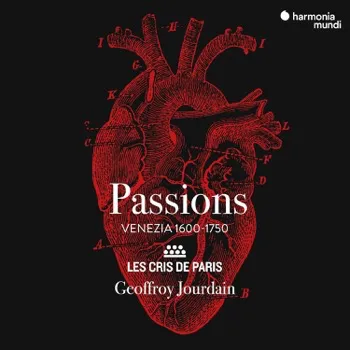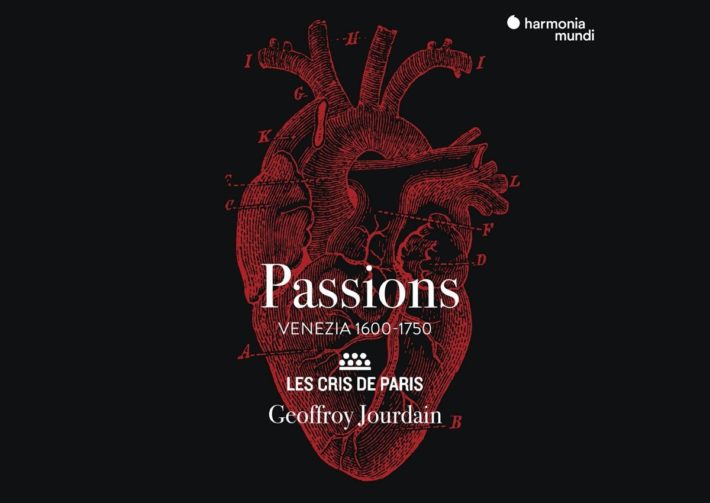Les Cris de Paris and Geoffroy Jourdain — the acclaimed early music orchestra, choir, and their leader — are back at it with a new album of Renaissance and Baroque music. This time, it’s an all-Venetian cast of composers. Multiple threads run through the album: there is Time’s arrow, as Monteverdi teaches Cavalli teaches Legrenzi teaches Lotti; there is the Passion itself, with four settings of the Nicene Crucifixus; and there is a passion, from the soloists, ensemble, and the more obliquely religious texts.

Soprano Michiko Takahashi opens the album with a gritty yet touching depiction of Mary singing a strangely hallucinatory lullaby. Mary is desperate — she is having visions of the crucifixion, but also desperately wants her baby to fall asleep. The rocking chromaticism from the continuo suggests a cradle, yet its harmonic instability foretells the peril that both Mary and listeners know waits for the babe. Takahashi alternates with virtuosic ease between lullaby and lament. She is almost choking on the text at times, other times nearly yelling, yet it never breaks the fourth wall. It is a standalone, one-woman, award-worthy drama. In retrospect, Christina Pluhar and others have performed this lullaby passably well, but Takahashi and Jourdain have outdone them all.
The following six tracks span about 10 years’ worth of Venetian music, allowing the listener to experience the flow of time through music. In Monteverdi’s Crucifixus, the influence of the Renaissance is still obviously audible. The counterpoint is relatively conservative, employing dissonance sparsely and clearly separating the voices. It doesn’t lack for harmonic invention or text painting, though. It is contemplative and stimulating without being overwhelming. Cavalli’s Salve Regina is noticeably more melodically driven; one could argue for prominence of the soprano voice in the opening, and for the importance of homophony (rather than strict counterpoint) in the following sections.
By the time we reach Lotti, we have solidly arrived in the Baroque era, announced by the string of wonderful suspensions that opens the Duetti. Here voices flow freely, and fugue with each other in practically freely modulating counterpoint. The Crucifixus à 10 that follows has strains of Vivaldi’s Winter, with its insistent bass line and use of the half step dominant-to-flatted-sixth relationship (also shared by the haunting lullaby that opens the album). In contrast to Monteverdi’s telling, this Crucifixus is intended to overwhelm. There are caveats to drawing generalizations like this — in track 19, for instance, Monteverdi shows that he can be just as engaging and free as some of his followers, and the singers clearly enjoy demonstrating this — but one must begin somewhere.
Les Cris de Paris deserves credit for bringing out these distinctions so aptly. The Monteverdi is painted with small and gentle brush strokes, but the colors are deep. Whether it’s the soloists in the Crucifixus or the whole choir in the Adoramus, the vocal performance is totally without pretension, employing vibrato as necessary, yet restrained, never letting the sound move past Monteverdi’s realm. The listener reflects. Then, as Time moves forward, so expands the choir’s techniques.
In the Cavalli and Lotti, the singers become more emotional, allowing in a less refined but equally compelling method of vocal production (e.g. “passus,” 2’07” track 7). There is a wonderful freedom of rhythm that Baroque performances too often lack. It’s never imprecise, but there is a heartbeat, which speeds and slows with the music. One can practically hear the singers glancing at each other to coordinate entrances. The text comes across as clearly as if spoken — and yet they are singing. The listener feels.
I have neglected the orchestral players because the singers are so wonderful, but the strings and continuo are also a pleasure to hear. Their instrumental interludes are not as engaging as the vocal numbers, but help space out the album.
Alban Moraud and Aude Besnard deserve mention for the audio engineering on the album, and Alexandra Evrard for the mastering. The recording has a deep bass presence with strong upper tones, and the sound resonates mysteriously well. It is not a lengthy or overbearing resonance, yet it has a soft and tangible quality. One can only hope for more recordings of vocal music from this crew and from the Temple du Saint-Esprit in Paris. Geoffroy Jourdain and his anonymous interviewer also deserve credit for immensely instructive liner notes.
This album didn’t immediately appeal to me; I found it dense, and the passions that are so clearly present in the first half seem to peter out by the end. We hear the crucifixion — where is the resurrection? Yet, given a few listens, its merits clearly outweigh these quibbles. The music is fabulous, and I will be returning many times.
“Passions”
Les Cris de Paris
Geoffroy Jourdain – Conductor
Harmonia Mundi, CD HMM902632




















